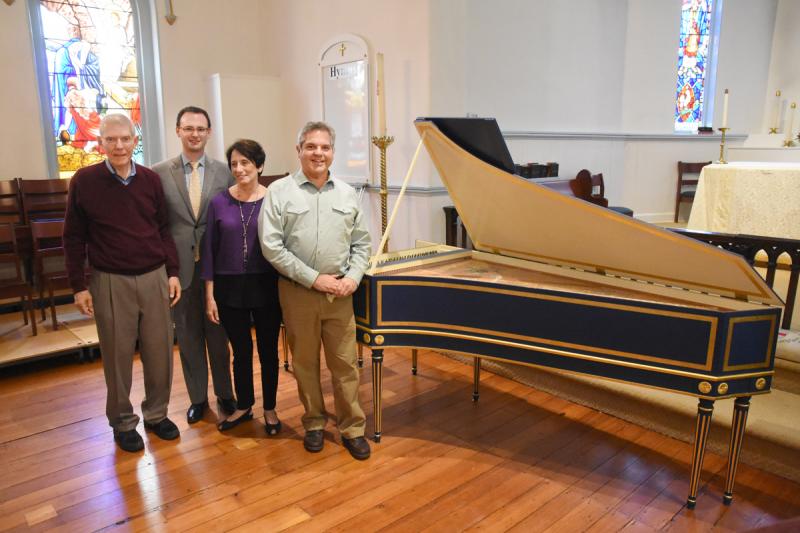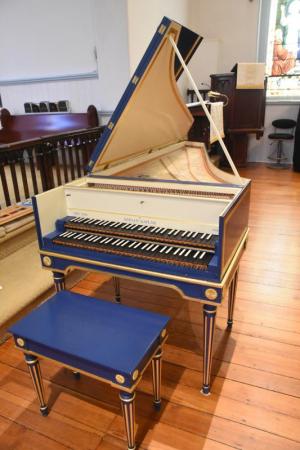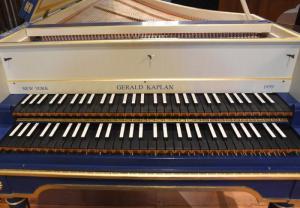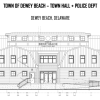Harpsichord brings new life to St. Peter’s Church

When Gerald Kaplan decided to spend his free time in 1998 and 1999 building a harpsichord in his one-bedroom Manhattan apartment, he had absolutely no experience in making instruments.
It was a massive project, one he undertook purely for his love of the instrument.
While attending Florida State University, Kaplan took a class on music history and was required to attend a recital. The one he randomly selected was a Johann Sebastian Bach recital featuring the violin and a harpsichord.
"When they played, I almost didn't hear the violin," he remembered. "I was so woken up by the harpsichord because it was just so bright and beautiful."
Considered a predecessor of the modern-day piano, the harpsichord looks something like a piano, but takes a different approach on the inside. Where a piano strikes the strings, a harpsichord has a mechanism that plucks them. Unlike a piano, where the harder a key is struck the louder the sound, a harpsichord releases the same volume no matter how hard the keys are struck.
The harpsichord was most prominent in the 17th and 18th centuries, but it had a resurgence in the 20th century, thanks in part to two New England-based companies - Zuckermann Harpsichords and Hubbard Harpsichords.
Before starting the massive undertaking of building a harpsichord, Kaplan took a workshop at Hubbard in Massachusetts. While there, the staff helped him get the project started. The rest, he said, was on him. Kaplan bought a kit for a French double harpsichord from Hubbard, in which the company offers the supplies and step-by-step instructions for building the instrument.
"They just deliver a gigantic hunk of wood," said Kaplan, a software developer who moved to Lewes in 2015. "It comes as lots of pieces of wood. Nothing is really assembled at that point."
"This is not like Ikea, where it's a piece of furniture that you just bolt together," said Kaplan, adding the kit's instructions were about an inch thick. "Everything has to be cut and mitered."
Kaplan worked on the harpsichord during his free time. Hubbard offered a one-hour window each day where kit builders could call the factory with questions.
"I would run home from work at the end of the day to make the phone call in their little window of time," he said. "I wasn't a skilled woodworker, so sometimes I wouldn't know the terminology or how to do certain things."
Kaplan's harpsichord has upper and lower keyboards, each with its own volume. The upper keyboard can be pushed in, which allows the lower keyboard to pluck two strings simultaneously for a louder sound.
The finishing touch was an ornate paint job. Kaplan's harpsichord is blue with gold trim on the outside. Beneath the strings, Queens-based French artist Monique painted birds, flowers and other personal touches.
Kaplan loved the final product, but shortly after completing it, he moved to Japan and he couldn't take the bulky instrument along. It was put in storage. Upon his return, he sold his first harpsichord to a friend in Brooklyn.
While in Japan, Kaplan built a second harpsichord. This time he went for a smaller version, a Flemish harpsichord. He loved it so much, he brought it back when he returned, and it still sits in his home.
T.J. Thomas, the minister of music at St. Peter's Episcopal Church in Lewes, borrowed Kaplan's Flemish harpsichord for a concert earlier this year. The instrument was such a hit, Thomas said, the church was interested in acquiring one.
Kaplan and Thomas traveled to New York City to look at two harpsichords – one being the first Kaplan had built. "I absolutely did not want to bias his decision, but deep down I was hoping he would select [mine]," Kaplan said.
Once Thomas made a selection, Kaplan offered half the money to acquire the harpsichord. The other half was donated by parishioners Michael and Barbara Alushin.
St. Peter's new harpsichord, Kaplan's original, debuted in a Lewes Chamber Players concert April 30. Renowned violinist and violist Sylvia Ahramjian, and composer and guitarist Allen Krantz tailored a portion of their concert to the harpsichord. Thomas joined the duo for two pieces and played solo for one Bach selection. "The touch is much closer to the organ than the piano," Thomas said of playing the harpsichord. "With a piano, you have variability – the harder you hit, the more sound it makes. With a harpsichord, it's not that way."
The harpsichord is also extremely susceptible to the environment, specifically humidity and changes in temperature. The instrument has to be carefully tuned before every use. "Part of the art of playing the harpsichord is also tuning," Thomas said. "[Kaplan] has been a great mentor for me in that way, on how to care for the instrument. It's not difficult, but it takes time."
Thomas said the church's new harpsichord will primarily be used by the St. Cecilia Guild at St. Peter's. The guild's concert series is anchored by its resident ensemble, the Lewes Chamber Players, and features other regional choirs and ensembles throughout the year. The harpsichord will also be used when needed during church services with choir and orchestra.
Kaplan is extremely proud his harpsichord will be so close to home and will be appreciated. "I'm happy it will be played in a more concert setting instead of being a piece of furniture in someone's house," he said. "I feel like I'm part of the process ... somebody who helps make early music available here in Lewes."


























































